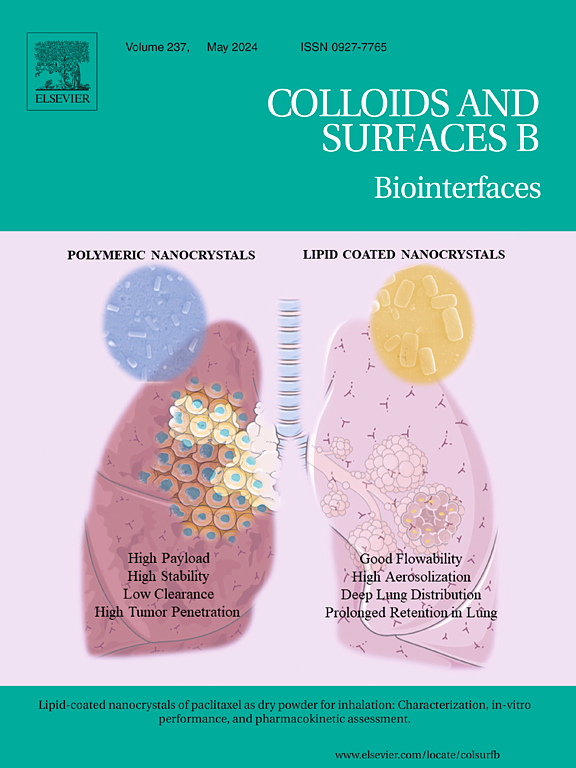Drug loaded hydrogel nanoparticles with long retention in tumor and multi drug co delivery for melanoma treatment
IF 5.4
2区 医学
Q1 BIOPHYSICS
引用次数: 0
Abstract
This study aims to address the issue of immune clearance and inaccurate targeting of drug-loaded nanoparticles during intravenous injection, which may lead to partial drug release into non target tissues or organs, damage to normal tissues and low drug utilization. Herein, multi-drug co-delivery nanoparticles with intratumoral long retention capability were developed for melanoma treatment. This study adopted a dual drug loading strategy of curcumin and dexamethasone and designed a drug-loaded nano-system based on polyglutamic acid and caffeic acid. The results indicate that the introduction of caffeic acid endowed nanoparticles with the property of long-term retention in melanoma sites, while also obtaining a certain inhibitory effect on melanoma growth and good antioxidant properties. To make nanoparticles more stable in water environment, we employed esterification reaction to introduce ester bond to enhance the water resistance of nanoparticles, thus giving them stability in water environment. Two drugs with different hydrophilicity were co-loaded into nanoparticles through grafting and π-π stacking. The experimental results in vitro and in vivo indicate that such strategy and design have achieved long-term retention of nanoparticles at tumor site, and meanwhile allow nanoparticles to effectively inhibit the growth and metastasis of tumor cells, achieving ideal therapeutic effects on melanoma treatment.
在肿瘤中长期保留的载药水凝胶纳米颗粒和多药联合递送用于黑色素瘤治疗
本研究旨在解决载药纳米颗粒在静脉注射过程中免疫清除和靶向不准确的问题,这可能导致药物部分释放到非靶组织或器官,损害正常组织和药物利用率低。本研究开发了具有肿瘤内长期滞留能力的多药共递送纳米颗粒用于黑色素瘤治疗。本研究采用姜黄素和地塞米松双重载药策略,设计了基于聚谷氨酸和咖啡酸的载药纳米体系。结果表明,咖啡酸赋予纳米粒子具有长期滞留黑色素瘤部位的特性,同时对黑色素瘤的生长也有一定的抑制作用和良好的抗氧化性能。为了使纳米颗粒在水环境中更加稳定,我们采用酯化反应引入酯键来增强纳米颗粒的耐水性,从而使纳米颗粒在水环境中具有稳定性。通过接枝和π-π堆积将两种亲水性不同的药物共负载到纳米颗粒中。体外和体内实验结果表明,该策略和设计实现了纳米颗粒在肿瘤部位的长期滞留,同时允许纳米颗粒有效抑制肿瘤细胞的生长和转移,对黑色素瘤的治疗达到理想的治疗效果。
本文章由计算机程序翻译,如有差异,请以英文原文为准。
求助全文
约1分钟内获得全文
求助全文
来源期刊

Colloids and Surfaces B: Biointerfaces
生物-材料科学:生物材料
CiteScore
11.10
自引率
3.40%
发文量
730
审稿时长
42 days
期刊介绍:
Colloids and Surfaces B: Biointerfaces is an international journal devoted to fundamental and applied research on colloid and interfacial phenomena in relation to systems of biological origin, having particular relevance to the medical, pharmaceutical, biotechnological, food and cosmetic fields.
Submissions that: (1) deal solely with biological phenomena and do not describe the physico-chemical or colloid-chemical background and/or mechanism of the phenomena, and (2) deal solely with colloid/interfacial phenomena and do not have appropriate biological content or relevance, are outside the scope of the journal and will not be considered for publication.
The journal publishes regular research papers, reviews, short communications and invited perspective articles, called BioInterface Perspectives. The BioInterface Perspective provide researchers the opportunity to review their own work, as well as provide insight into the work of others that inspired and influenced the author. Regular articles should have a maximum total length of 6,000 words. In addition, a (combined) maximum of 8 normal-sized figures and/or tables is allowed (so for instance 3 tables and 5 figures). For multiple-panel figures each set of two panels equates to one figure. Short communications should not exceed half of the above. It is required to give on the article cover page a short statistical summary of the article listing the total number of words and tables/figures.
 求助内容:
求助内容: 应助结果提醒方式:
应助结果提醒方式:


